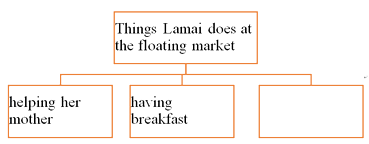题型:阅读理解 题类:常考题 难易度:普通
湖南省永州市2017-2018学年高一上学期英语期末质量监测试卷
City Life in Thailand is much like city life in the United States. People live in tall buildings or in houses close together. But outside the cities, life is different. People usually live on farms far apart from one another. They grow their own food or buy fresh food almost every day at the market. But the market is not in a building. It is a floating market located on a river.
Lamai and her family live on a farm. They grow fruits and vegetables and sell them at the market each day. Long before the sun comes up, Lamai and her brother help their parents. They pick out fruits and vegetables and clean them. Then they load everything into a long boat.
Their boat is ready by about 6:00 a.m. Lamai and her mother row to the closest floating market. On the way the water is still and peaceful. Lamai sees the bright sun beginning to shine.
Soon Lamai hears laughing and yelling in the distance. Her mother rows the boat around a corner. Suddenly they are at the floating market. Hundreds of boats are gathered at a wide place in the river. Lamai's mother is selling bananas and ripe tomatoes today. For Lamai a trip to the market is more than just a chance to sell or buy something. It is a chance for her to talk to her friends.
Today Lamai sees her friend Suki. He is helping his mother prepare meals in their boat. Lamai loves the smell of the fried bananas Suki's mother is making. Lamai's mother rows over to buy a late breakfast. As Lamai eats, she and Suki talk about their summer plans.
At around 11:00 a.m. people begin to go home. She is sleepy from waking up so early. Her mother has sold most of what they brought to the market. The will leave the market with less food in their boat but with more money for Lamai's family.

试题篮